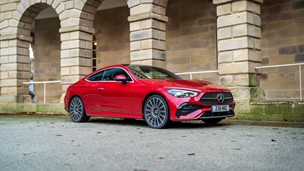Now in its second generation, the 300C is American in its badge and styling but is built in Canada and has an Italian engine. Customer choice is nowhere near as wide as it used to be. There is no longer an estate version, there's just one trim level and UK customers can only have a diesel engine, though this was by far the most popular option in the days when other units were available.
With a list price of just over £30,000 without options, the 300C is a large and well-equipped car for a relatively small amount of money. This and its imposing styling are probably two of the most compelling reasons to buy it instead of an Audi A6, BMW 5 Series or Mercedes E-Class.
Performance
The single engine available, a 3.0-litre V6 diesel, is one of the best things about the 300C. It's very quiet - so quiet, in fact, that you could fool an unobservant passenger into believing that it actually runs on petrol - and its maximum power output of 236bhp makes the car more than adequately lively.
There are certainly faster cars on the road, but the 300C's 7.4-second 0-62mph time and 144mph are more than enough. As you might expect from an engine of this type, flexibility is also very good. 121bhp is available from as little as 1,600rpm.
Ride and Handling
The suspension does its best to make the car absorb bumps in the road well, but this is spoiled to some extent by the 20-inch wheels and 45-section tyres.
The 300C behaves well enough on country roads as long as you're don't push it too hard. If you do, the handling becomes more laborious and you might wish you'd spent extra money on a German rival after all. The suspension does its best to make the car absorb bumps in the road well, but this is spoiled to some extent by the 20-inch wheels and 45-section tyres. When the current 300C was introduced in 2012, Chrysler fitted some models with 18-inch wheels and higher-profile tyres, but following a subsequent rationalisation of the range these are no longer available, presumably because most customers preferred the look of the 20-inch wheels.
Interior and Equipment
Although most 300Cs have been built in the 21st century, the first car of that name was the 1957 version of Chrysler's 'letter series' models.
Considering its price, the 300C is quite extravagantly equipped, with nappa leather upholstery, heated front and rear seats (the former being ventilated too), adaptive cruise control, adaptive headlights, a powered sunroof, a rear sunshade, a reversing camera, blind spot monitoring and heated, folding and auto-dimming door mirrors all fitted as standard. One of the very few extra-cost options is a Harman Kardon audio upgrade including no fewer than nineteen speakers. Rear passenger space isn't as generous as the size of the car might lead you to believe, and although the boot isn't exactly cramped its 481-litre capacity is comparable with that of Audis, BMWs and Mercedes one size down.
Cost
The big Chrysler has official combined fuel economy of 39.2mpg (other 3.0-litre diesels do far better than this) and its CO2 emissions are at 191g/km.
Perhaps the outstanding feature of the 300C is that you can pay at least £10,000 more for similarly sized and less well-equipped models from other manufacturers, though it's worth bearing in mind that the gap will close considerably at resale time. Running costs can expected to be on the high side. The big Chrysler has official combined fuel economy of 39.2mpg (other 3.0-litre diesels do far better than this) and its CO2 emissions are at 191g/km. That CO2 figure pushes the 300C just into Porsche territory, means that annual Vehicle Excise Duty payments amount to £265 and the Benefit In Kind rating, 35% at the time of writing, will reach the top bracket of 37% in April 2017.
Our Verdict
There's a lot to like about the 300C. It still looks very distinctive, even though the styling has been toned down since the early days, and in many way it's very refined. The V6 diesel engine on-board impresses in terms of its performance and how quietly it runs. It should have more space for luggage and rear passengers than it does, though, and although it's remarkably cheap to buy it could cost quite a bit to run. There's also the question of how many people will be willing to take it off your hands once you've finished with it.




